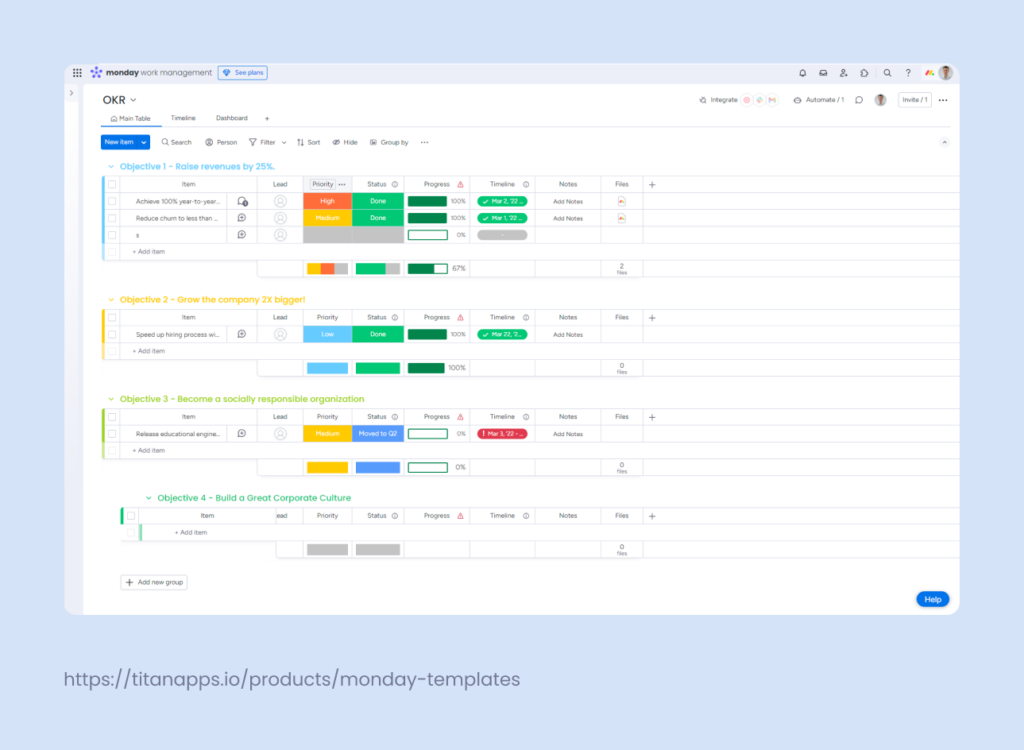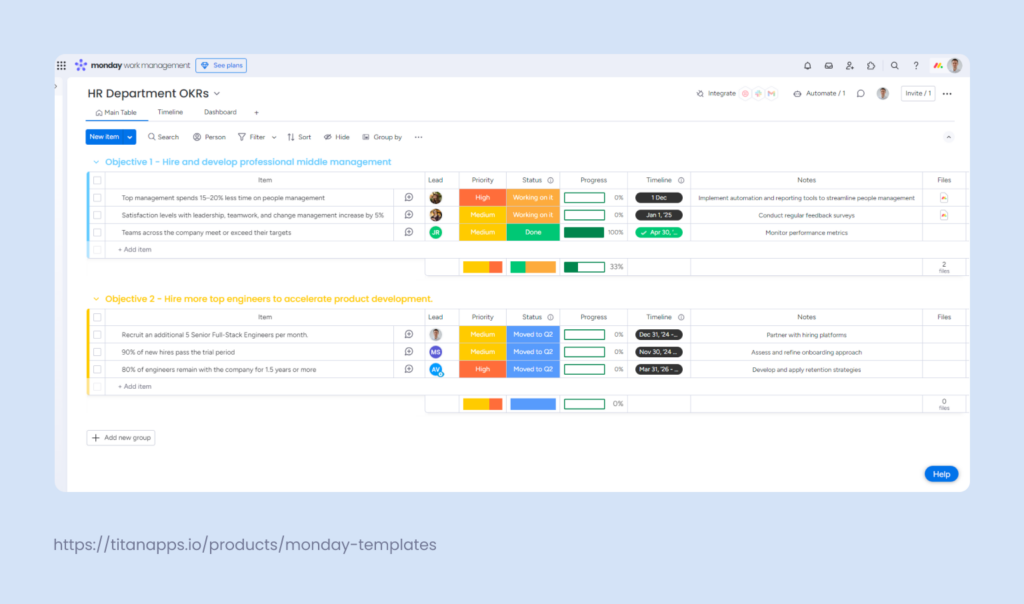If you’ve ever set ambitious goals only to watch them slip into the “backlog” as daily tasks consume your time, you’re not alone. The OKR (Objectives and Key Results) framework is a structured approach that helps many teams stay consistent and not lose sight of the bigger picture. But even with a solid framework, goals can still slip through the cracks.
Using monday.com’s OKR template keeps objectives visible, helping ensure they are tracked consistently and pursued effectively.
In this article, I’ll cover OKR examples, show you how to set up an OKR board in your monday.com workspace, and share some practical tips.
What exactly are OKRs?
Objectives and Key Results is a goal-setting methodology that helps define clear, measurable goals and, more importantly, track their outcomes.
The framework is particularly popular because it aligns individual team members’ efforts with the company’s broader mission, thus fostering transparency and focus.
Here is what a typical OKR approach looks like:
- Objective – needs to be clear, meaningful, and time-bound, providing clear direction but maintaining flexibility.
- Key Results – should be specific, measurable, and include verifiable metrics that track progress toward the objective within a defined timeframe.
As an example, let’s take an IT company that has just received significant investment and is growing quickly. This surge of capital brings both opportunities and challenges. To make the most of this growth, the company’s leaders realize they need to expand their team, improve internal processes, and boost employee satisfaction. Naturally, the HR team is tasked with meeting these goals.
To tackle this challenge effectively, the HR team begins by setting clear business objectives and defining key results:
Objective 1: Hire and develop professional middle management to rapidly achieve results, implement changes, and enhance team communication and coordination.
Next, they set three key results that will measure the effectiveness of strengthening middle management in improving efficiency and freeing up top management’s time.
- Key Result 1: Top management spends 15–20% less time on people management, freeing up time for strategic areas such as strategy, product development, and investor relations.
- Key Result 2: Satisfaction levels with leadership, teamwork, and change management in the company increase by 5%.
- Key Result 3: Teams across the company meet or exceed their targets, maintaining a high level of productivity.
Objective 2: Hire more top engineers to accelerate product development.
To achieve this, they establish key results focused on recruiting high-quality engineers efficiently and ensuring they become long-term contributors.
- Key Result 1: Recruit an additional 5 Senior Full-Stack Engineers per month.
- Key Result 2: 90% of new hires pass the trial period.
- Key Result 3: 80% of engineers remain with the company for 1.5 years or more.
With these OKRs clearly defined, the HR team now has a strategic roadmap to navigate the company’s rapid growth. However, like any methodology, it’s important to understand its advantages and potential drawbacks.
Pros and Cons of the OKR Framework
With the example above in mind, let’s explore the pros and cons of using the OKR framework.
Pros:
- OKRs are typically reviewed quarterly or even monthly. This regular evaluation allows teams to adapt to changes quickly and stay aligned with evolving priorities and milestones.
- Everyone knows exactly what is expected, which actions to take, and how success will be measured.
- When team members set their own goals and how to measure them, they become more engaged and feel more responsible for their work.
While OKRs offer many advantages, incorrect use of the framework often leads to drawbacks.
Cons:
- Prioritizing measurable results too much can make teams overlook important things like employee happiness or customer satisfaction.
- Without clear communication, teams might set goals that don’t align with company goals, leading to confusion and wasted effort.
- The OKR process can become too complicated and reduce its effectiveness.
Another key point to be aware of is that effectively implementing OKRs requires a platform that simplifies goal-setting and progress tracking.
How to set up an OKR board in monday.com?
monday.com offers a large selection of native templates for different use cases that can be customized to suit specific needs.
Among these is the OKR template, which has all the fundamental elements needed for an effective OKR workflow and can easily be updated to any team’s unique goals.

The template comes with four pre-set sections for company objectives, organized as groups on the board. Each objective group includes items for key results and columns for priorities, status, progress, timeline, notes, and files.
However, while the template clearly organizes OKRs, it lacks specific sections for implementation tasks tied to each OKR. To manage this effectively, the primary option is to use sub-items under each key result. This allows you to outline specific actions and assign them to relevant team members directly within the template, keeping everything in one place.
For more complex tasks that require detailed planning, you can create separate linked boards. These boards can be connected to the OKRs in a separate column that shows each task’s progress and status.
Let’s take a look at how an HR Team Lead from the earlier example can use this template with their given OKRs.
1. Renaming the objectives: The HR Team Lead begins by renaming the objectives to match those relevant to their team. This is done by clicking on the group name in the template and editing it directly. For instance, to reflect their primary objective, they would rename the first group to:
- “Hire and develop professional middle management.”
2. Updating key results: The next step is to update the items listed under each objective to reflect the specific key results. The template includes two predefined items with all necessary columns, which the Team Lead can rename to match two key results from the example, such as:
- “Top management spends 15–20% less time on people management.”
- “Satisfaction levels with leadership, teamwork, and change management increase by 5%.“
3. Adding additional key results: Since the first objective has three key results, the HR Team Lead will need to add one more item. This can be easily done by clicking the “+ Add item” button within the relevant group and naming the new item according to the additional key result:
- “Teams across the company meet or exceed their targets.”
4. Adjusting columns and details: The final step involves reviewing and adjusting the columns for priorities, status, progress, and timeline to ensure they align with each key result.
The HR Team Lead can also attach any necessary notes or files directly in the corresponding columns to provide additional context or documentation.
5. Adding related tasks:
- Use sub-items: For each key result, the HR Team Lead can add sub-items to outline specific actions and assign them to team members.
- Create linked boards: If any key result requires more complex planning, the Team Lead can set up a linked board and connect it in a separate column to display progress and status.
6. Cleaning up the board: After setting up the rest of the objectives and key results, the HR Team Lead can remove any unused groups, items, columns, notes, or placeholders from the original template.
Once all of this is done, the final results will look like this:

Best practices for managing OKRs with monday.com
Implementing OKRs is only the first step in achieving your goals. The second step is managing them effectively, which requires consistent effort and is something that a simple template can’t solve. It’s about creating a process where goals are actively pursued, tracked, and adapted in real-time based on the team’s progress.
Here are the top 3 practices that should go hand-in-hand with your monday.com OKR template:
1. Create a dashboard for a better overview of your OKRs. A well-designed dashboard provides a visual snapshot of your team’s progress, making it easier to see where you stand at any given moment. With monday.com, you can customize your dashboard to highlight key metrics, track trends, and spot potential bottlenecks in your initiatives.
2. Make communication a priority throughout the OKR process. While the OKR framework aligns everyone with the bigger picture, ongoing communication is still essential. As business goals and strategies can shift, regular updates help keep all stakeholders on the same page. Continuous check-ins and open dialogue ensure that the team stays focused on achieving the objectives.
3. Track everything and improve based on results. It’s essential to maintain a continuous loop of tracking and feedback. Regularly update the status of your key results to reflect real-time progress. By doing so, you can identify areas that need more attention or adjustment before they become critical issues. This data-driven approach ensures that teams remain agile and efficient in their task management.
To better understand this point, let’s check in with our HR team and the type of KPIs they would track to ensure their OKRs are on course:
- Application review time: monitoring the application review time supports the key result of hiring an additional 5 Senior Full-Stack Engineers per month. The HR team can use monday.com’s timeline column to track each step of the review process, ensuring it meets the one-business-day goal for engineering positions.
- Candidate NPS: Regularly tracking the candidate’s Net Promoter Score (NPS) aligns with the key result of ensuring 90% of new hires pass the trial period. To gather NPS, the HR team can integrate survey tools like Zonka Feedback or SurveyMonkey with monday.com, which automatically updates scores and comments in a dedicated column on the board.
- Turnover rates: tracking turnover rates, especially within the first year, helps assess the effectiveness of hiring and onboarding. Higher-than-expected turnover may indicate issues with job fit or onboarding, requiring deeper analysis.
- Time to hire: This KPI is crucial for achieving the key result of hiring an additional 5 Senior Full-Stack Engineers per month. The HR team can use monday.com’s automation to track timelines for each role. For example, they set up an automation that triggers an alert or changes the status to ‘Delayed’ if a hiring stage exceeds the set timeframe.
Whether you’re just getting started with OKRs or refining your OKR management approach, monday.com helps streamline the process, making it easier for your team to stay focused and achieve your goals effectively.
So set the objectives wisely, track your progress consistently, make adjustments as needed, and success will follow!